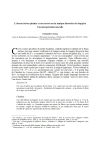Françoise Lecocq
« L’oiseau bĂ©nou-phĂ©nix et son tertre sur la tunique historiĂ©e de Saqqâra. Une interprĂ©tation nouvelle »
ENiM 12, 2019, p. 247-280.
 Depuis la découverte en 1922 de la tunique historiée de Saqqâra, les études se sont succédé pour la dater et l’interpréter, sous différents angles. Dans ce document d’époque romaine, on a reconnu le bénou d’Héliopolis sur la butte de la création originelle. Mais l’iconographie de l’oiseau est influencée par le mythe gréco-romain du phénix, puisqu’un jeu de mots remplace le traditionnel héron cendré par un flamant rose, phoinikopteros, tel qu’il se voit aussi approximativement à la même époque sur la monnaie d’Hadrien intronisant le phénix comme symbole impérial ; il n’a pas un « bec de vautour » en référence au hiéroglyphe de l’année. Quant à la butte, son curieux décor ne montre ni « bandelettes sacrées », ni « flammes », ni « rochers » symbolisant les douze mois de l’année, mais treize plants de papyrus et les sept bouches du Nil, c’est-à -dire une image gréco-romaine du delta, dans une lecture topographique horizontale qui se superpose à la lecture verticale et temporelle.
Depuis la découverte en 1922 de la tunique historiée de Saqqâra, les études se sont succédé pour la dater et l’interpréter, sous différents angles. Dans ce document d’époque romaine, on a reconnu le bénou d’Héliopolis sur la butte de la création originelle. Mais l’iconographie de l’oiseau est influencée par le mythe gréco-romain du phénix, puisqu’un jeu de mots remplace le traditionnel héron cendré par un flamant rose, phoinikopteros, tel qu’il se voit aussi approximativement à la même époque sur la monnaie d’Hadrien intronisant le phénix comme symbole impérial ; il n’a pas un « bec de vautour » en référence au hiéroglyphe de l’année. Quant à la butte, son curieux décor ne montre ni « bandelettes sacrées », ni « flammes », ni « rochers » symbolisant les douze mois de l’année, mais treize plants de papyrus et les sept bouches du Nil, c’est-à -dire une image gréco-romaine du delta, dans une lecture topographique horizontale qui se superpose à la lecture verticale et temporelle.
 Since the discovery in 1922 of the decorated tunic of Saqqâra, the studies followed one another for its datation and interpretation, under various angles. On this document from the Roman era, one recognized the benu of Heliopolis on the primeval hill of the creation. But the iconography of the bird is influenced by the Graeco-Roman myth of the phoenix, because a pun allows to replace the traditional grey heron (ardea cinerea) by a pink flamingo, phoinikopteros, as it can also be seen, approximately at the same time, on Hadrian's currency inaugurating the bird as an imperial symbol ; it does not have « the beak of a vulture » in reference to the hieroglyph of the year. As for the mound, its curious decoration does not show a « sacred garland », neither « flames » nor « rocks » symbolising the twelve months of the year, but thirteen stems of papyrus and the seven mouths of the Nile, that is an Graeco-Roman image of the delta, in a horizontal topographic reading superimposed upon the vertical and temporal reading.
Since the discovery in 1922 of the decorated tunic of Saqqâra, the studies followed one another for its datation and interpretation, under various angles. On this document from the Roman era, one recognized the benu of Heliopolis on the primeval hill of the creation. But the iconography of the bird is influenced by the Graeco-Roman myth of the phoenix, because a pun allows to replace the traditional grey heron (ardea cinerea) by a pink flamingo, phoinikopteros, as it can also be seen, approximately at the same time, on Hadrian's currency inaugurating the bird as an imperial symbol ; it does not have « the beak of a vulture » in reference to the hieroglyph of the year. As for the mound, its curious decoration does not show a « sacred garland », neither « flames » nor « rocks » symbolising the twelve months of the year, but thirteen stems of papyrus and the seven mouths of the Nile, that is an Graeco-Roman image of the delta, in a horizontal topographic reading superimposed upon the vertical and temporal reading.
 Consulter cet article (36772) -
Consulter cet article (36772) -  Télécharger cet article au format pdf (18576)
Télécharger cet article au format pdf (18576)
ENiM 18 - 2025
4 article(s) - 11 mars 2025.
ENiM 1 à 18 (2008-2025) : 223 articles
4 019 434 téléchargements
8 332 240 consulations.
Index des auteurs

Mots clés

Derniers articles : 
Robert Steven Bianchi
Duplication and Continuity
(ENiM 18, p. 13-36 — 11 mars 2025) 
Frédéric Mougenot
Rénénoutet à la porte de la maison
(ENiM 18, p. 1-12 — 29 janvier 2025) 
CENiM - Mise en ligne des volumes Ă©puisĂ©s : 
 Anne-Sophie von BOMHARD DĂ©cans Ă©gyptiens, CENiM 23, Montpellier, 2020 — (2020)
Anne-Sophie von BOMHARD DĂ©cans Ă©gyptiens, CENiM 23, Montpellier, 2020 — (2020) 
 Jean-Claude Grenier L'Osiris ANTINOOS, CENiM 1, Montpellier, 2008 — (26 dĂ©cembre 2008)
Jean-Claude Grenier L'Osiris ANTINOOS, CENiM 1, Montpellier, 2008 — (26 dĂ©cembre 2008) 
TDENiM - Mise en ligne des volumes Ă©puisĂ©s : 
 Twitter
Twitter 3615197 visites - 4709 visite(s) aujourd’hui - 199 connecté(s)
© ENiM - Une revue d’égyptologie sur internet
Équipe Égypte Nilotique et Méditerranéenne - UMR 5140 - « Archéologie des Sociétés Méditerranéennes » (Cnrs) - Université Paul Valéry - Montpellier III






















 Contact
Contact
 Abonnez-vous !
Abonnez-vous ! Équipe Égypte Nilotique et Méditerranéenne
Équipe Égypte Nilotique et Méditerranéenne UMR 5140 « Archéologie des Sociétés Méditerranéennes » (Cnrs)
UMR 5140 « Archéologie des Sociétés Méditerranéennes » (Cnrs) Université Paul Valéry - Montpellier III
Université Paul Valéry - Montpellier III